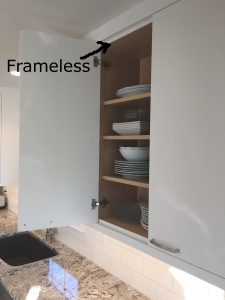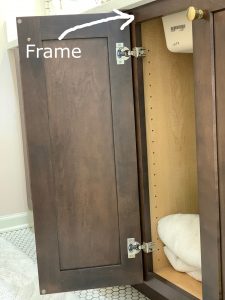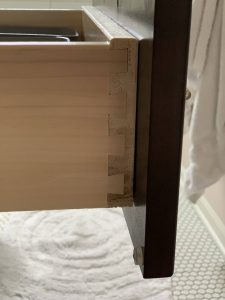On our latest podcast episode, we welcome Annette Hoesli of Can Am Sales Inc. She brings to us a wealth of cabinet experience as she’s been working in the cabinet industry for nearly 30 years. Can Am Sales Inc., is an independent sales representative agency working with over 500 cabinet dealers.
Quality grades in cabinets?
Stock
Stock cabinets are specific sizes. They usually offer one, one or two-door styles and have very few finishes or wood species available. The sizes are in three-inch increments, 12 or 15 and 18. And if those don’t fit in what you need to do it’s too bad. That would be a stock cabinet.
Semi-Custom
Semi-custom is one step up from stock cabinets. You’ve got a few more door styles available and a few more wood species. They’re made per order so you can’t just go in somewhere and buy them off the shelf.
Semi-custom cabinets allow you to modify your sizes. So, if you need a 19-inch-wide cabinet, you can get a 19-inch-wide cabinet. Semi-custom just offers a few more modifications that you can do to them.
Custom
Custom allows you to do whatever you want to do, meaning you can order special sizes. They also allow all kinds of modifications, whether you need to angle the back or front, put up a chase in the back because there’s a flue going up through the wall, or whatever else it may be.
There are also lots of different wood species and finishes available in custom cabinets. If you want to do a custom match paint or stain, custom-made cabinets are your best bet.
How do these different quality grades impact projects in terms of price and timing?
Well, of course, as you go up from stock to semi-custom to custom the price is going to go up because there are more options available. Your stock cabinets are going to be your least expensive. And as far as lead time and getting your cabinets in, the custom is going to take longer. You’re ordering special things. They need the time to either do that special finish that you want or make that special configuration of your cabinet. So, lead times in a normal world on custom cabinets are a little bit longer than semi-custom. And then the stock is usually a little bit quicker.
Lead-time varies a little bit with stock cabinets. Some of them are a week normally but can be up to three weeks during normal demand. With semi-custom cabinets, you’ll see anywhere from three to five weeks and then custom anywhere from six to eight weeks.
Right now, there are manufacturers that are at 12 weeks. And a few that are out even further than that. Even the stock lines are delayed, some of them are out at eight weeks, which is just crazy for a stock line.
Framed vs. Frameless Cabinets
If you think of your cabinet as a box, which is what we call it in the industry. You’ve got your top, your bottom, your sides, your left and right sides, and your back. That would be a frameless cabinet. There’s no front on it because that’s where your door goes, the fourth side is literally your door. This style gives you have full access to the interior of the cabinet. You’ll hear frameless referred to as frameless, full access, or European construction.
In a face frame cabinet, you’ve got your box, your top, your bottom, your left, and right end panels in your back. But then there is also a picture frame over the front of it. Generally, these frames are an inch and a half wide. This frame is over the front and then your door sits on top of that picture frame. When you open your door, you have the frame on the front of your cabinet, so you don’t have necessarily full access. You’ve got to get around that face frame. Your drawer boxes are smaller and your interior is a little smaller than your cabinets.
As far as price, there’s no difference. So that’s, that’s the difference between framed and frameless.
Importance of dovetail joints in drawers
Dovetail joints are in your drawer boxes. There just isn’t a better way to hold your drawer box together. Generally, the bottom of the drawer box fits in a slot on the side. This is called a captured bottom rather. You’ll know you don’t have a captured bottom if when you slam your silverware drawer shut, all the knives are sticking out the back the next time you open it.
Cabinet thickness
Cabinet thickness does vary however not in frameless cabinets. They are always a three-quarter inch, top, bottom, and sides but the back can vary a little bit. The face frame cabinet does vary, sometimes the end pane, the tops, and bottoms are half an inch or they might be three eights or three quarter. Generally, when you get to your finished ends or your outside ends, you want a full three-quarter-inch end panel there. But otherwise, you just don’t want to get too thin on any part of your cabinet.
Cabinet materials
A lot of people ask for an all-wood box, they don’t mean solid wood because cabinets are built out of solid wood. The doors and face frame, yes but not the tops bottoms and backs. The actual cabinet construction is either built out of plywood, particleboard, or MDF. MDF is a medium density fiberboard that is considered one step up from particleboard. Annette said the preference is generally plywood.
If you’re painting the cabinets there is nothing wrong with an MDF, because it’s a nice, smooth finish and you’re going to be painting it. Particleboard has its applications in stock and semi-custom cabinets. You don’t generally see particle board in a custom cabinet. If you are looking for custom and the manufacture is using particleboard, you probably don’t want that. Look for an MDF or plywood
There are different qualities in plywoods because they have different cores in them. You may see a five, seven, or nine ply. Generally, the more plies in your plywood, the better quality it is.
Does wood species impact your cabinet quality?
Not necessarily. There are some wood species that are softer than others. Knotty Alder or Alder is a softer wood, pine or knotty pine is a softer wood. So, the harder the wood you get theoretically the longer it’s going to last or look better. You’re not going to have dents and dings in it and things like that.
When you get into Oak and cherry they’re both hardwoods. They’re going to hold up well. Hickory is also a very hard wood. They’re all going to hold up really well. The ones that are a little bit harder to source or that there isn’t a large quantity such as mahogany and Walnut are going to be a little bit higher priced, but quality-wise, they’re all going to hold up well.
Type of wood for painted cabinets
Generally, all manufacturers use a paint-grade maple. It’s not standard maple because paint-grade maple might have some mineral streaks and things like that in it that are going to be covered up with paint. So, it’s a little bit more cost-effective to purchase paint-grade maple for a manufacturer than it is to paint just regular maple.
There are some companies that make an all MDF door so it’s not a solid wood door, it’s an MDF door. And sometimes it’s made one piece. MDF doors are going to finish well because you won’t see any wood graining through them. The other advantage to an MDF door is that it doesn’t expand and contract like real wood will. And so theoretically you won’t get your expansion and contraction. If you’re painting an all-wood door it’s going to expand and contract. It will crack it in the joints.
Cabinet Finishes
There is a big difference between finishing cabinets once they’re installed vs. finishing them in a factory. When finishing in a home you’ve got dust and dog hair and whatever else is in the home. Or if it’s new construction, there’s all of the dust from construction. This is what the industry calls trash and when cabinets are finished in the final space, they run a greater risk of picking up trash. This means it’s not going to be that smooth finish. You don’t have the baked finish wherein a factory it’s in an enclosed environment. Cabinets go through finish booths that spray an even thickness of paint or stain to them. Because it’s all machine applied, it’s even. They also go through ovens in the factory and are fully cured before they’re touched.
Almost everyone uses in manufacturing uses a catalyzed conversion varnish. It is a great finish that Crestwood used for years. They now use a two-part Italian polyurethane finish which is something that is used over in Europe. Over there, they don’t use catalyzed conversion varnish. They’ve just gone to the next best thing, which is a two-part polyurethane. The polyurethane is more durable and more flexible.
Ability to fix cabinets should something happen
Should an issue arise with your cabinets, call your cabinet reseller and they can work to get you a new door or a touch-up kit. A touch-up kit is a marker and a putty stick. Your reseller can even help you get the correct paint or stain or whatever else you may need. Generally, unless it’s years and years down the road, they’re still going to have that door style and the capability of making that door replicating that finish. The only caveat is that stained cabinets age. For example, a year from now your cherry cabinet will have a different hue so a new door will be lighter. Give it a while, around a year and it will blend.
Cabinet Warranty
Different manufacturers have different warranties. Crestwood is a limited lifetime warranty and that is pretty common in custom cabinets. When you get into your lower lines, like stock cabinets, they’re going to have maybe a five-year warranty. This is often due to quality; they’re just not going to hold up for a limited lifetime. Another reason is stock cabinets are often used in apartments and rentals. Places that see more wear and tear.
Look for future episodes on Apple, Spotify, Google, or Sticher. We’ll also make sure to share each episode right here on our blog.



